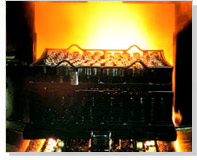 Heat Treatment is a method of controlled heating and cooling of metals to alter their mechanical and physical properties without changing the product shape. The technique involves the use of heating or chilling, usually to extreme temperatures, to attain a desired result, such as - hardening or softening of a metal. Some of the common techniques of heat treatment include annealing, case hardening, precipitation strengthening, tempering and quenching. As a matter of fact, the term heat treatment applies only to processes where the heating and cooling is done for the basic objective of altering the properties intentionally. Heating and cooling, however, sometimes occur as incidental phases of other manufacturing methods such as hot forming or welding.
Heat Treatment is a method of controlled heating and cooling of metals to alter their mechanical and physical properties without changing the product shape. The technique involves the use of heating or chilling, usually to extreme temperatures, to attain a desired result, such as - hardening or softening of a metal. Some of the common techniques of heat treatment include annealing, case hardening, precipitation strengthening, tempering and quenching. As a matter of fact, the term heat treatment applies only to processes where the heating and cooling is done for the basic objective of altering the properties intentionally. Heating and cooling, however, sometimes occur as incidental phases of other manufacturing methods such as hot forming or welding.
Primarily associated with increasing the strength of material, heat treatment can also be used to change certain manufacturing objectives such as improved machining, improved formability, and to restore ductility after a cold working operation. Hence it is a very enabling manufacturing process, which can not only help other manufacturing methods, but can also enhance product performance by increasing the strength or other desirable characteristics.
TypesThe four basic types of heat treatment processes used today are -
- Annealing
- Normalizing
- Hardening
- Tempering
The techniques used in each method and how they relate to steel workers are given below -
Annealing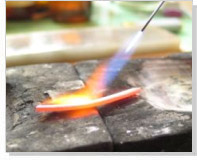 Generally, annealing is the opposite of hardening. Metals are annealed to relieve internal stresses, to soften them, to make them more ductile, and to refine their grain structures. Annealing comprises of heating a metal to a particular temperature, holding it at that temperature for a definite time, and then cooling the metal to room temperature. The cooling process depends on the metal and the characteristics desired. Some metals are furnace-cooled, while others can be cooled by burying them in ashes, lime, or other insulating materials.
Generally, annealing is the opposite of hardening. Metals are annealed to relieve internal stresses, to soften them, to make them more ductile, and to refine their grain structures. Annealing comprises of heating a metal to a particular temperature, holding it at that temperature for a definite time, and then cooling the metal to room temperature. The cooling process depends on the metal and the characteristics desired. Some metals are furnace-cooled, while others can be cooled by burying them in ashes, lime, or other insulating materials.
Welding produces areas, which have molten metal next to other areas, which are at room temperature. As the weld cools, internal stress occurs along with brittleness and hard spots. Welding can in reality weaken the metal. Annealing is just one of the techniques used for correcting these problems.
Normalizing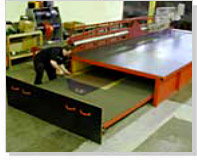 A type of heat treatment applicable to ferrous metals only, normalizing differs from annealing in that the metal is heated to a higher temperature, which is then removed from the furnace for air cooling.
A type of heat treatment applicable to ferrous metals only, normalizing differs from annealing in that the metal is heated to a higher temperature, which is then removed from the furnace for air cooling.
The basic objective of normalizing is to remove the internal stresses caused by heat treating, welding, casting, forging, forming, or machining. If not controlled, stress can result in metal failure; hence, before hardening the steel, it should be first normalize to get the desired results. Generally, low-carbon steels do not require normalizing; however, if they are normalized, they do not cause any harmful effects. Usually, the castings are annealed, instead of normalizing; however, some castings require normalizing.
Normalized steels are stronger and harder than annealed steels. In the normalized condition, steel is much sturdier than in any other structural condition. Parts subjected to impact and those, which require maximum toughness with resistance to external stress are generally normalized. In normalizing, the mass of metal has an impact on the rate of cooling and on the resulting structure. Thin pieces cool faster and are sturdier after normalizing than thick ones.
Hardening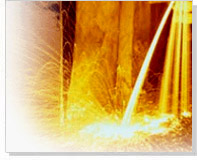 Metal hardening treatment constitutes of heating the steel to a definite temperature and then cooling it quickly by plunging it into oil, brine, or water. Majority of steels require rapid cooling (quenching) for hardening, however a few can be air-cooled with the same results. Although hardening enhances the hardness and strength of the steel, it makes it less ductile. Usually, the harder the steel, the more brittle it becomes. To remove some of the brittleness, the steel should be tempered after hardening.
Metal hardening treatment constitutes of heating the steel to a definite temperature and then cooling it quickly by plunging it into oil, brine, or water. Majority of steels require rapid cooling (quenching) for hardening, however a few can be air-cooled with the same results. Although hardening enhances the hardness and strength of the steel, it makes it less ductile. Usually, the harder the steel, the more brittle it becomes. To remove some of the brittleness, the steel should be tempered after hardening.
Many nonferrous metals can be hardened and the strength can be increased by controlled heating and rapid cooling. In this case, the process is called heat treatment, instead of hardening.
Tempering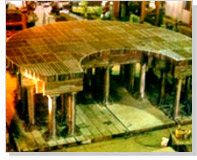 After hardening, steel is generally harder than required and is too brittle for most practical applications. In addition, stern internal stresses are set up during the speedy cooling from the hardening temperature. To relieve the internal stresses and to reduce brittleness, the steel should be tempered after it is hardened. Tempering process comprises of heating the steel to a particular temperature (below its hardening temperature), holding it at that temperature for a definite time, and then cooling it, generally instill air. The final hardness, strength, and ductility depends on the temperature to which the steel is heated during tempering.
After hardening, steel is generally harder than required and is too brittle for most practical applications. In addition, stern internal stresses are set up during the speedy cooling from the hardening temperature. To relieve the internal stresses and to reduce brittleness, the steel should be tempered after it is hardened. Tempering process comprises of heating the steel to a particular temperature (below its hardening temperature), holding it at that temperature for a definite time, and then cooling it, generally instill air. The final hardness, strength, and ductility depends on the temperature to which the steel is heated during tempering.
Primarily, tempering is done to reduce the brittleness imparted by hardening and to generate specific physical properties within the steel. Tempering always follows, never precedes, the hardening process. Besides reducing the brittleness, tempering helps in softening of steel. That is unavoidable, and the amount of hardness, which is lost depends on the temperature, which the steel is heated to during the process of tempering.
Tempering is always exercised at temperatures below the low critical point of the steel. In this regard, tempering differs from annealing, normalizing, and hardening, wherein the temperatures are above the upper critical point.
Heat Treatment of SteelSteels are especially suitable for heat treatment, as they react well to heat treatment and the commercial applications of steels exceeds that of any other material. Steels are heat treated for one of the following reasons:
- Softening
- Hardening
- Material Modification
Common Heat Treatments
Some of the common heat treatments include -
Softening:Softening is a heat treatment process, which is done to reduce strength or hardness, remove residual stresses, improve toughness, restore ductility, refine grain size or alter the electromagnetic attributes of the steel. Removing residual stress or restoring ductility is an essential operation when a high amount of cold working is to be performed, like in a cold - rolling operation or wire drawing.
Hardening:Hardening is done to increase the strength and wear properties of metal. One of the pre-requisites for hardening of metals is adequate alloy and carbon content. If there is adequate carbon content then the steel can be directly hardened. If this is not the case, the surface of the part has to be carbon enriched using some diffusion methods / hardening techniques.
Material Modification:Material modification is a heat treatment method, which is used to alter the properties of metals in addition to softening and hardening. The process is used to modify the behavior and characteristics of steels as per desired.
